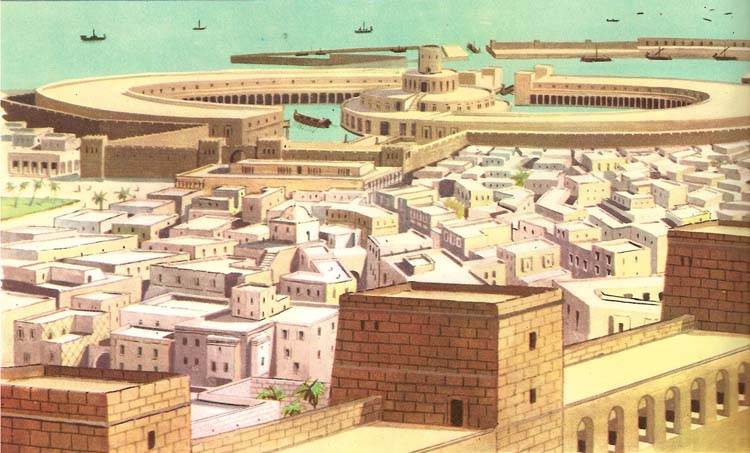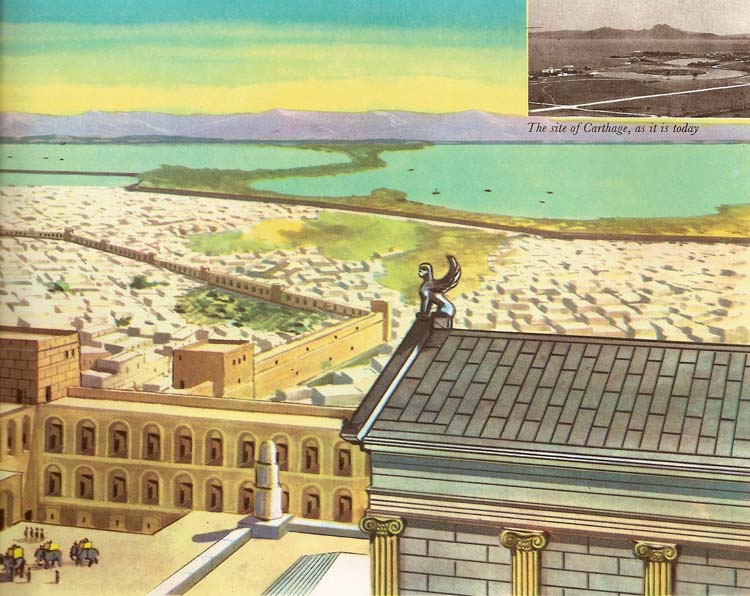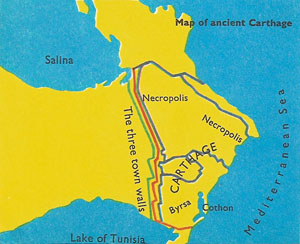Carthage

Reconstruction of Carthage by L. Aucler.

The reconstruction of Carthage shown in the two pictures to the right was made by L. Aucler, an archeologist who devoted his life to the study of Carthaginian civilization. By means of painstaking research among the few remaining traces of the ancient city, and with the help of descriptions found in the works of classical writers (especially the Roman historian, Appian) he was able to reconstruct the probable appearance of the ancient city.
Thus the defense system of the city looked like one gigantic fortress. The space beneath the arches was divided into two stories. In the lower one there were stalls for 300 elephants and storage space for their fodder. On the upper one there were stables and haylofts for 4,000 horses as well as barracks for 4,000 cavalry and 20,000 infantry. The houses of the city were tall, sometimes having as many as six stories, and they were built very close together. The streets were narrow, like trenches. This arrangement had advantages, for with winding narrow streets the defense of a city is much easier. Not only can the streets be bridged by planks to enable the defenders to move across the rooftops, but attackers are herded in a narrow space and thus make easier targets.
 |
Government
The market square was near the sea. From its center there arose a temple to Apollo, beside which stood the majestic senate house, the headquarter's of the city's government. At first, Carthage was governed by two "judges," chosen by election from among the most prominent families. But with time this office became of little importance, and the supreme power came to be vested in 30 senators, who were of the noble class. The Carthaginian nobility lived outside the city, on large estates cultivated by slaves. Within the city lived the poorer classes, the tradesmen, and the merchants. These merchants, as their riches grew, became jealous of the power of the nobles, and finally they succeeded in overthrowing the noble Senate and entrusting the government to the "Hundred," an assembly controlled by themselves.
The power of Carthage was founded on several things: there were a number of hidden supply stations which seamen and caravan leaders had everywhere from the Sudan to the Baltic; there were mines of precious metals; they had certain techniques of manufacture and of sea and land navigation. But her greatest achievement, and the one of which she was most proud, was the size of her fleet.
The port
To anyone approaching from the sea, Carthage seemed to have no port and no fleet. Where did she hide her hundreds of merchant ships and warships? On the low, sandy beaches, thousands of slaves had dug a huge circular canal, over 1,000 feet wide. This was the naval base. It was made invisible from the sea by an enormous circular arcade, with columns on the inside and a blank wall on the outside. It could not be seen for what it was even from the city.
This arcade provided berths for at least 220 ships, and there both loading and building could be carried on. But no one could tell whether the fleet was there unless they were actually inside.
In the center of the port, which was called a cothon (meaning "cup"), there was a small round island. On this island stood the stronghold of the Admiral of the Fleet.
From here, by means of trumpet signals, officers directed the work of the gangs of laborers in the port. From the turret which topped the stronghold, ships approaching the port could be spotted at some distance.
The city
The center of the city was situated on a low hill called Byrsa. Here the Carthaginians built their shrines and enclosed them with another belt of fortified walls. Here was the citadel, the city within a city, where, in the event of invasion, everyone could gather for a final stand.
In the citadel was forum containing temples dedicated to the city's gods: Esmun, the war god; Baal, the sun god; Astarte, the moon goddess. When the city was threatened, the statue of Baal was borne into the courtyard of the temple. It was shaped like a human body with outstretched arms and had the head of a bull. Sacrifices, sometimes human, were made to placate it. The human victims were chosen from the sons of the city's noblest families.
In the artist's depiction of Carthage above can be seen the two ancient harbors (marked today by two lagoons) the circular cothon, and the outer rectangle.
